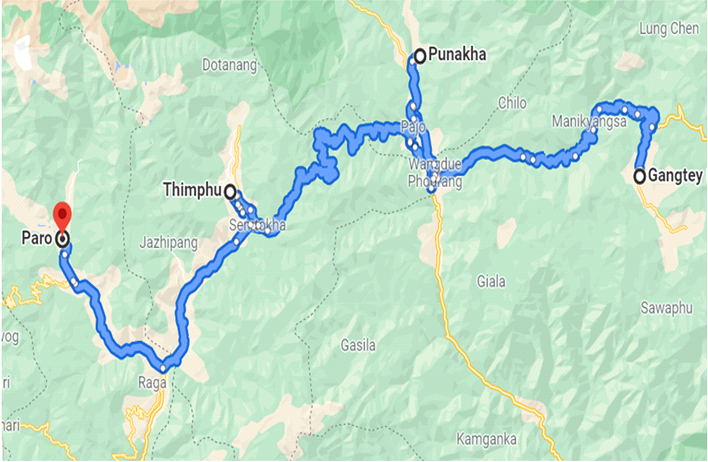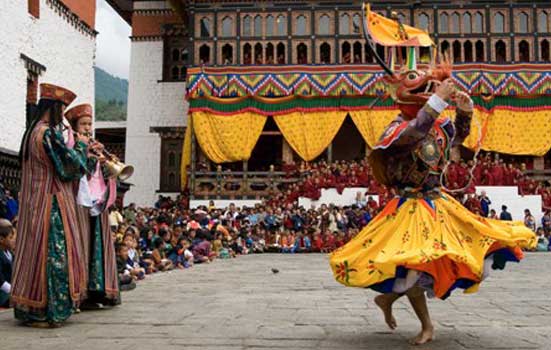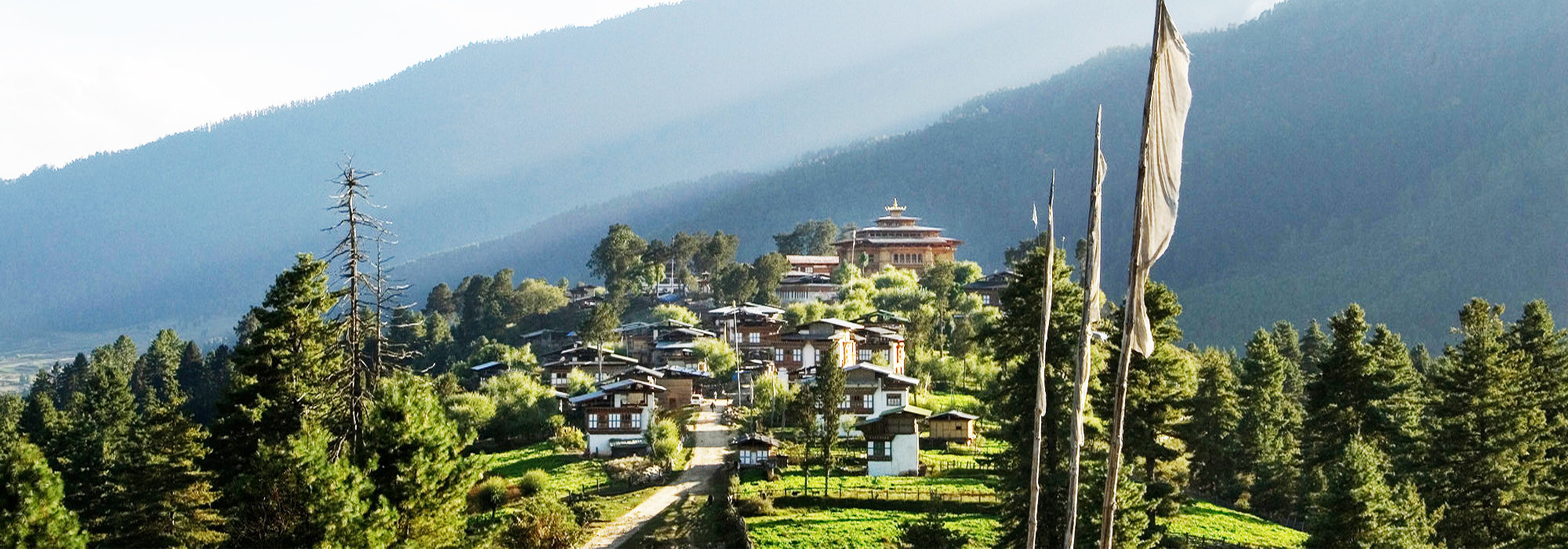Private Bhutan Roundtrip
Route : Paro Thimphu Gangtok Punakha Paro
9 Days 8 Nights
Overview
Private Bhutan Roundtrip
Location Map

Itinerary
-
1Day 1 : ARRIVE PARO BY DRUK AIR & TRANSFER TO THIMPHU (55km, approx. 1.1/2 hour drive)
The flight to Paro is one of the most spectacular in entire Himalayas. Flying along the Himalayan range from Kathmandu, the journey offers fascinating views and an exciting descent into the Kingdom. Bhutan’s first gift to you as you disembark from the aircraft will be cool, clean fresh mountain air. After immigration formalities’ you will be welcomed by our representatives. Afterwards drive to Thimphu, the capital town of Bhutan with en-route stop at Chuzom, the confluence of Thimphu and Paro rivers. Three different style of stupas; Tibetan, Nepalese and Bhutanese adorn this confluence. Shortly before reaching Chuzom, you will see on your left Tschogang Lhakhang, “the temple of the excellent horse”. It is a private temple, built in 15th century, as the result of visitation from Balaha, the excellent horse, a manifestation of Chenrezig, the compassionate Buddha. On arrival, in Thimphu check-into the hotel. The capital town of Bhutan and the centre of government, religion and commerce, Thimphu is a unique city with unusual mixture of modern development alongside ancient traditions. With the population of about 90,000 it is perhaps still the world’s only capital city without a traffic light. Take an evening stroll through the Craft Bazar recently established under patronage of Department of cottage & small industry and in collaboration with the department of culture, tourism council and the department of agriculture marketing and cooperatives, this market offers genuine Bhutanese arts & crafts thus contributing in promotion, protection and preservation of traditional arts, and the main town of Thimphu. Overnight at the hotel in Thimphu.
-
2Day 2 : THIMPHU
Thimphu, perhaps the most unusual capital city in the world, is the seat of government. This bustling town is home to Bhutan’s royal family, the civil servants, and foreign missions with representation in Bhutan. It is also the headquarters for a number of internationally funded development projects. Morning after breakfast walk around National Memorial Chorten, a large white structure crowned with a golden spire. It is located close to the center of Thimphu city and is one of its most iconic monuments. This is the most ideal spot to interact with locals who throng in large numbers to circumambulate the chorten, whirl the large red prayer wheels and pray at a small shrine inside the gate. The paintings and statues inside the monument provide a deep insight into Buddhist philosophy. Afterwards take a short drive to the north of town to Buddha Point (Kuensel Phodrang). Located at a short drive from Thimphu city centre, visitors can get a good overview of the Thimphu valley from the Buddha point (Kuensel Phodrang). You can pay your obeisance and offer prayers to the Buddha, the largest statue in the country and then walk around and take a glimpse of the valley. Followed by visit to the National Library which houses an extensive collection of Buddhist literature, with some works dating back several hundred years as well as modern academic books mainly on Himalayan culture and religion. Return to your hotel for lunch. After Lunch National Textile Museum, these museums have been open in 2001 and provide a fascinating insight into Bhutanese material culture and art of textile. This afternoon there are plenty of opportunities to immerse in the rich culture this kingdom has to offer. Next visit to Simply Bhutan - an exclusive project under the Bhutan Youth Development Fund. It is a living Museum and Studio encapsulating the cultural heritage of the Bhutanese people. The infrastructure portrays ancient Bhutanese architecture which is being lost to modernization. Your final visit before returning to your hotel is to visit Trashichhoedzong, “fortress of the glorious religion”. This is the center of government and religion, site of monarch’s throne room and seat of Je Khenpo or Chief Abbot. Built in 1641 by the political and religious unifier of Bhutan, Shabdrung Ngawang Namgyal, it was reconstructed in 1960s in traditional Bhutanese manner, without nails or architectural plans. Evening at leisure. Overnight at the hotel in Thimphu.
-
3Day 3 : THIMPHU – GANGTEY (150km, approx. 6-7 hours drive)
After breakfast enjoy a dramatic drive over the high mountain pass of Dochu La (3,O8Om) and on to the Phobjikha Valley passing through dense forests and oak, rhododendron tress. The journey continues over the 3,050m mountain pass where on a clear day, the towering Himalayan peaks are clearly visible. The highway follows the scenic Dang Chhu before climbing through forests of bamboo and oak. After checking into hotel, explore Gangtey village and Phobjikha valley on foot. Overnight at the hotel in Gangtey. (Altitude 3000m).
-
4Day 4 : GANGTEY
The valley of Gangtey is one of the most beautiful spots in Bhutan. The surprise of finding such a wide, flat valley without any trees after the hard climb through dense forests is augmented by an impression of vast space, and extremely rare experience in Bhutan where most of the valley’s are tightly enclosed. A few kilometers beyond the Gangtey Monastery, on the valley floor lies the village of Phobjikha. This place is the winter home of black necked cranes that migrate from the arid plains in the north to pass winter in milder and lower climate. Phobjikha, at an altitude of 2900 m, falls under the district of Wangduephodrang and lies on the periphery of the Black Mountain National Park. Embark on walk along the Gangtey Nature Trail. Later visit Gangtey Gompa. Perched on a small hill that rises from the valley floor, the Gangtey Monastery is the only Nyingmapa monastery on the western side of the Black Mountain’s and also the biggest Nyingmapa monastery in Bhutan. The Monastery is surrounded by a large village inhabited mainly by the families of the 140 Gomchens who take care of the Monastery. Overnight at the hotel in Gangtey (Altitude 3000m).
-
5Day 5 : GANGTEY – PUNAKHA (70 km, approx 3-4 hrs drive)
Morning after breakfast drive to Punakha, Enroute excursion to Fertility Temple or Chimmi Lhakhang, ‘Chemi’ literally means ‘No Dog’. The 15th century Buddhist Master Drukpa Kinley (Divine Mad man) reached the place chasing the demon from Dochola who took the form of a dog. It is here on this spectacular hill the Divine mad man caught the demon, killed her, buried her and built a black stupa marking as the seal on the evil. He left a piece of Ivory which has the shape of a phallus and said ‘later on this hill which looks like a young woman’s Breast a temple will be built and this piece will represent me that time to bless man and women with children and protection. Indeed, a Master known as Ngawang Chogyal, a cousin brother of Druk Kuenlay himself built a temple on this very hill near the black stupa. To this day the Temple, renovated several times stands and houses a monastic school and the Ivory piece is used to bless people of all kinds who come to seek blessing for Fertility, Prosperity, Long Life and protection. The Temple more popularly came to be known as Fertility Temple because of Divine Mad man’s teaching. The trail to Chimmi Lhakang takes about 30 minutes and passes through farm lands of Lobesa Village. As you walk along you will get the opportunity to see farmers at work. Chemi lhakang hike, the journey to fertility temple: Distance: 30 minutes approximately one way. Altitudes: 1500 meters Elevation Gain: 20 meters Difficulty Level: Easy Evening stroll around Punakha Town. Overnight at the hotel in Punakha.
-
6Day 6 : PUNAKHA
After breakfast at hotel, proceed to visit Punakha Dzong, a massive structure built at the junction of two rivers. It was the capital of Bhutan until 1955, and still serves as the winter residence of the monk body. Later in the day walking excursion to Khamsum Yulley Namgyal Chorten: A beautiful hike takes one to the regal Khamsum Yuelley Namgel Chorten, which was built to remove negative forces and promote peace, stability and harmony in the changing world. The Chorten dominates the upper Punakha Valley with commanding views across the Mo Chhu and up towards the mountainous peaks of Gasa and beyond. Return for lunch at the hotel. Visit The village of Talo and Nobgang,in the afternoon drive south west of Punakha. It will be a slow drive along winding, hilly roads up to a height of 2,800 Meters to the village of Talo, with houses scattered along hill slopes, this village is known in the brochures for its ‘cleanliness and hygiene’ among Punakha village. We will have opportunity to see their vegetable and flower garden and learn about their daily living. Overnight at the hotel in Punakha.
-
7Day 7 : PUNAKHA – PARO (125 kms, approx. 4 hours drive)
After breakfast, transfer to Paro. The beautiful valley of Paro encapsulates within itself a rich culture, scenic beauty and hundreds of myths and legends. It is home to many of Bhutan's oldest temples and monasteries, National Museum and country's only airport. Mount. Chomolhari (7,314m) reigns in white glory at the northern end of the valley and its glacial water plunge through deep gorges to form Pa Chhu (Paro river). Paro is also one of the most fertile valley in the Kingdom producing a bulk of the locally famous red rice from its terraced fields. Stop at Dochu la Pass shortly for freshening up. On arrival check in to your hotel followed by lunch. After lunch, your first visit from Paro will be to Ta Dzong. Once a watchtower, built to defend Rinpung Dzong during inter-valley wars of the 17th century, Ta Dzong was inaugurated as Bhutan's National Museum in 1968. Today it holds a fascinating collection of art, relics, religious Thangkha paintings and Bhutan's exquisite postage stamps. The museums circular shape enhances its varied collections displayed over several floors. Drive to visit Rinpung Dzong, which has a long and fascinating history. Built in 1646 by Shabdrung Ngawang Namgyal, the first spiritual and temporal ruler of Bhutan, the Dzong houses the monastic body of Paro, the office of the Dzongda (district administrative head) and Thrimpon (judge) of Paro district. The approach to the Dzong is through a traditional covered bridge called Nemi Zam. A walk through the bridge, over a stone inlaid path, offers a good view of the architectural wonder of the Dzong. Visit Kyichu Lakhang, one of the oldest and most sacred shrines of the Kingdom dating back to 7th century. The lhakhang complex is composed of two temples. The first temple was built by Tibetan King, Songtsen Gampo in the 7th century and in 1968, H.M. Ashi Kesang, the Queen Mother of Bhutan, built the second temple in same original pattern. Return to your hotel and either take an evening stroll. Overnight at the hotel in Paro.
-
8Day 8 : PARO
On arrival at trail-head point, embark on a walking excursion to Taktshang Monastery: It is one of the most famous of Bhutan’s monasteries, perched on the side of a cliff 900m above the Paro valley floor. It is said that Guru Rinpoche arrived here on the back of a tigress and meditated at this monastery and hence it is called ‘Tiger’s Nest’. This site has been recognised as a most sacred place and visited by Shabdrung Ngawang Namgyal in 1646 and now visited by all Bhutanese at least once in their lifetime. On 19 April 1998, a fire severely damaged the main structure of building but now this Bhutanese jewel has been restored to its original splendour. Return back to the hotel in time for lunch / or you can have a packed picnic lunch from the hotel. In the afternoon, drive down town in Paro to explore the charming traditional architecture, along with some shopping opportunities. Following an incredible day return to your hotel to relax, where you may enjoy the Spa facilities. Dinner and overnight in Paro.
-
9Day 9 : DEPART PARO
After an early breakfast at the hotel, drive to the airport for the flight to your onward destination. Our representative will help you with exit formalities and then bid you farewell.








